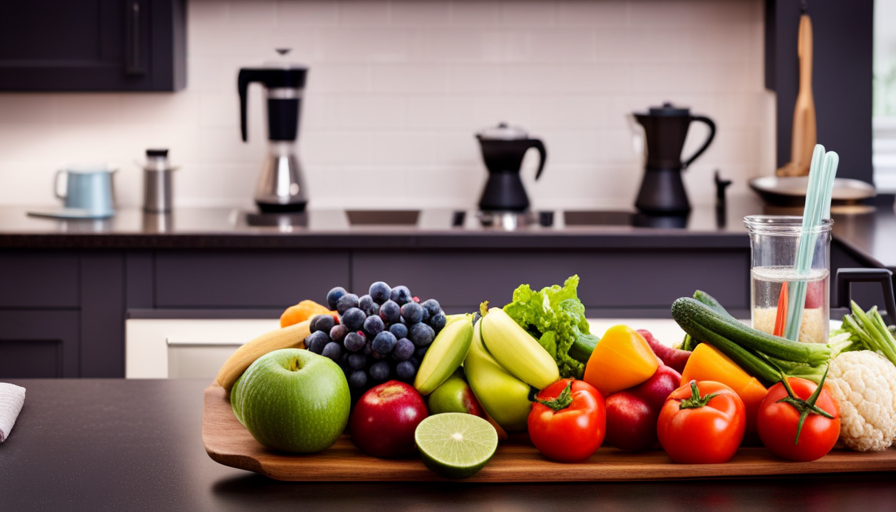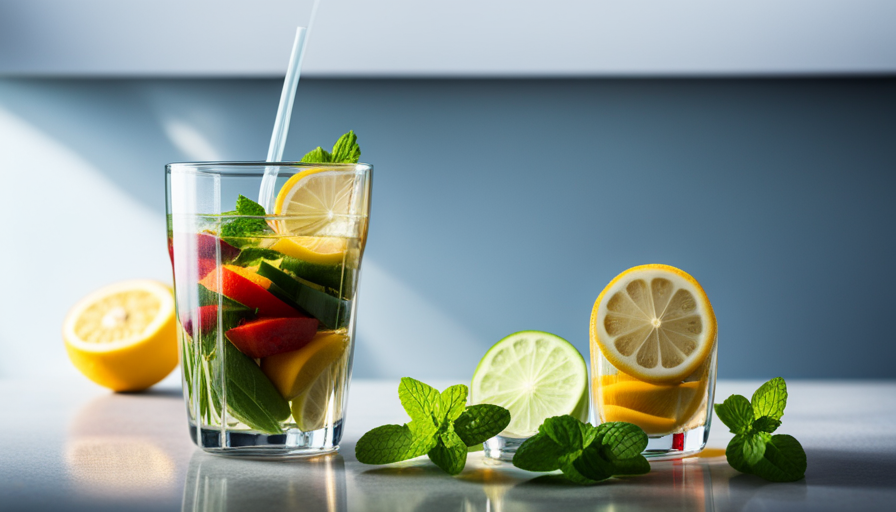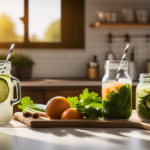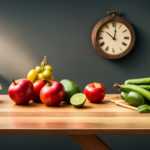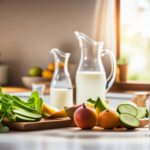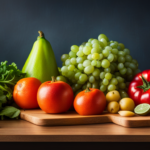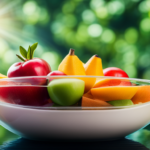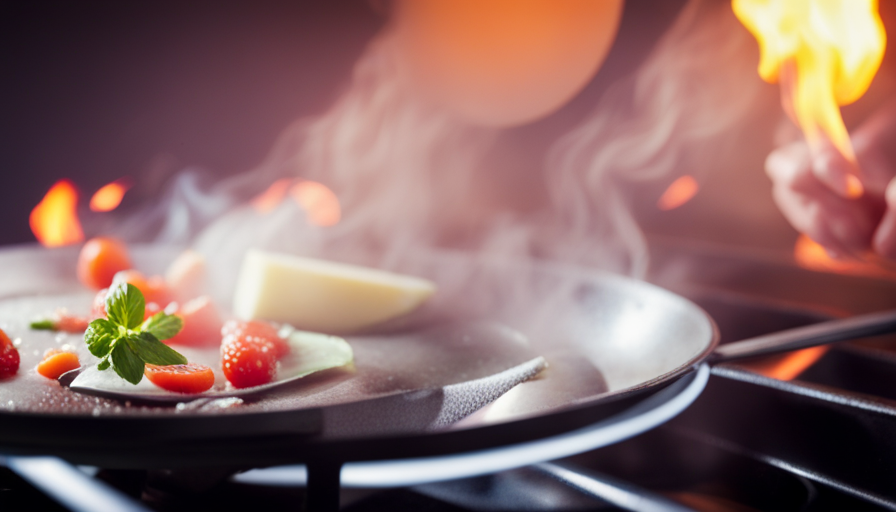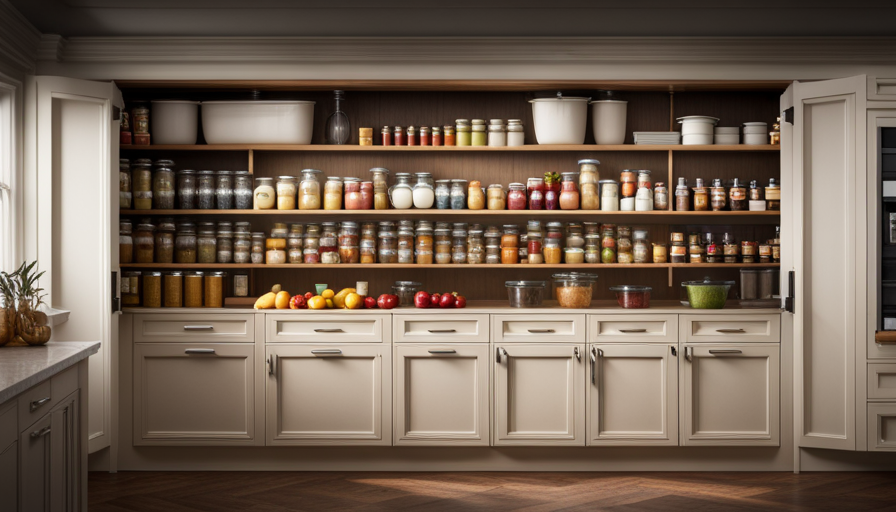Are you ready to transition away from your raw food detox? Discover the easiest way to finish this cleansing process while still giving your body the nutrition it needs.
In this article, we will outline a step-by-step guide to help you reintroduce cooked foods, incorporate nutrient-dense options, and find balance in your meal planning.
Listening to your body’s needs is key during this transition. By incorporating mindful eating practices and hydrating properly, you can ensure a seamless shift.
Additionally, we’ll discuss the importance of finding professional guidance if necessary and maintaining a healthy lifestyle post-cleanse.
To celebrate your accomplishment and ensure a successful transition, we’ll provide evidence-based tips to help you navigate this journey with ease. So, let’s dive into the world of post-cleanse nourishment and discover the best ways to go off a raw food cleanse.
Key Takeaways
- Gradually reintroduce cooked proteins, vegetables, and grains
- Listen to your body’s signals and honor cravings
- Incorporate nutrient-dense foods and hydrate properly
- Seek professional guidance and personalized meal plans
Gradually Reintroducing Cooked Foods
Now that you’ve successfully completed your raw food cleanse, it’s time to start reintroducing some cooked foods back into your diet! Gradually reintroducing proteins is an important step in transitioning from a raw food cleanse to a more balanced diet.
Cooked proteins such as chicken, fish, and tofu can provide essential amino acids and nutrients that may have been limited during your cleanse. Start by adding small amounts of cooked proteins to your meals and gradually increase the portion sizes over time.
This is also a great opportunity to try new recipes and experiment with different cooking methods. Grilling, baking, or sautéing your proteins can add new flavors and textures to your meals. You can explore various marinades and seasonings to enhance the taste of your cooked proteins.
Additionally, incorporating cooked vegetables and grains into your meals can provide a balanced and satisfying meal.
Remember to listen to your body and pay attention to how you feel after reintroducing cooked foods. Keep a food journal to track any changes or reactions you may experience. It’s normal to have some adjustments during this transition period, so be patient with yourself.
Enjoy the process of exploring new recipes and finding a balance that works for you.
Listening to Your Body’s Needs
First, it’s important to tune in to your body’s signals and honor its cravings as you transition from your nourishing journey. After being on a raw food cleanse, your body may have specific needs that are calling out to you. Intuitive eating is key during this phase, as it allows you to listen to what your body truly wants and needs.
This means paying attention to hunger cues, cravings, and satiety levels. To support your body in this transition, practicing self-care is crucial. Self-care practices can include activities like meditation, yoga, or gentle exercise to help you connect with your body and reduce stress. These practices can also aid in digestion and promote overall well-being.
Incorporating cooked foods back into your diet can be done gradually. Start by introducing lightly steamed vegetables or soups, and observe how your body responds. Pay attention to any changes in energy levels, digestion, and overall feelings of satisfaction.
Remember, each person’s journey is unique, and what works for one may not work for another. Trusting your body and giving yourself permission to experiment and find what feels best for you is key. By listening to your body’s needs and practicing intuitive eating, you can transition off a raw food cleanse in a way that supports your overall health and well-being.
Incorporating Nutrient-Dense Foods
To nourish your body and support its transition, start incorporating nutrient-dense foods that are packed with vitamins, minerals, and antioxidants. One way to do this is by consuming nutrient-dense smoothies. These smoothies can be made with a variety of fruits, vegetables, and superfoods. Some great options to include in your smoothies are leafy greens like spinach or kale, berries such as blueberries or strawberries, and a scoop of protein powder for an added boost. These smoothies are not only delicious but also provide your body with the essential nutrients it needs.
In addition to smoothies, incorporating healthy fats into your diet is crucial during the transition off a raw food cleanse. Healthy fats can be found in foods such as avocados, nuts, and seeds. These fats are important for brain health, hormone production, and overall wellbeing. Adding a handful of nuts or seeds to your meals or snacks can provide a satisfying crunch and help you feel more satiated.
To give you a better idea of nutrient-dense foods and their benefits, here is a table showcasing some examples:
| Nutrient-Dense Foods | Vitamins | Minerals | Antioxidants |
|---|---|---|---|
| Spinach | Vitamin A, C, K | Iron, Magnesium | Beta-carotene |
| Blueberries | Vitamin C, K | Manganese | Anthocyanins |
| Avocado | Vitamin K, E | Potassium | Lutein, Zeaxanthin |
| Almonds | Vitamin E, B2, B6 | Calcium, Magnesium | Antioxidants |
Incorporating these nutrient-dense foods into your post-cleanse diet will help ensure that your body receives the necessary nutrients to thrive.
Hydrating Properly
A common concern may be the fear of feeling dehydrated during the transition, but hydrating properly is essential for supporting your body’s needs and overall well-being. Proper hydration plays a crucial role in maintaining electrolyte balance and ensuring that your body functions optimally.
Here are two reasons why hydrating properly is important:
-
Electrolyte balance: When you consume raw foods, especially fruits and vegetables, they naturally contain a high water content. However, during a cleanse, your body may be eliminating toxins more rapidly, leading to increased fluid loss. By hydrating properly, you replenish the fluid lost and maintain a healthy electrolyte balance. Electrolytes such as sodium, potassium, and magnesium are essential for proper muscle and nerve function, as well as maintaining proper hydration levels.
-
Importance of water intake: Water is the most basic and essential nutrient for our bodies. It helps regulate body temperature, aids digestion, and supports nutrient absorption. During a raw food cleanse, it is important to drink enough water to prevent dehydration and support the detoxification process. Aim for at least 8 cups (64 ounces) of water per day, and consider adding herbal teas or infused water for added flavor and hydration.
Proper hydration is key to a successful transition off a raw food cleanse. By ensuring adequate water intake and maintaining electrolyte balance, you can support your body’s needs and promote overall well-being.
Finding Balance in Meal Planning
Finding balance in your meal planning is essential for maintaining a healthy and sustainable lifestyle. When coming off a raw food cleanse, it’s important to transition back to a regular diet gradually and mindfully.
One way to achieve this is through meal prepping. Planning your meals in advance allows you to have control over the ingredients and portion sizes, ensuring a well-balanced diet.
Start by incorporating cooked foods into your meals, such as steamed vegetables or grilled chicken, while still keeping a good portion of raw fruits and vegetables. This will help your body adjust to the change in digestion and prevent any digestive discomfort.
Additionally, be mindful of portion control. Use smaller plates and bowls to help you maintain appropriate serving sizes. This can prevent overeating and allow you to enjoy a variety of foods without feeling deprived.
When meal prepping, focus on including a variety of nutrient-rich foods such as whole grains, lean proteins, and healthy fats. This will help you meet your nutritional needs and keep you feeling satisfied throughout the day. Remember to listen to your body’s hunger and fullness cues and adjust your portion sizes accordingly.
By finding balance in your meal planning, you can successfully transition off a raw food cleanse and continue to nourish your body in a sustainable way.
Incorporating Whole Grains and Legumes
Incorporating whole grains and legumes into your meals can provide a burst of energy and make you feel like you could conquer the world. These nutrient-dense foods are a great addition to any diet, even if you’re coming off a raw food cleanse.
Cooking methods play a crucial role in ensuring the maximum benefits from whole grains and legumes. Soaking and sprouting legumes can help reduce their phytic acid content, making them easier to digest and increasing nutrient absorption. Cooking whole grains properly, such as simmering or steaming, can enhance their texture and flavor while preserving their nutritional value.
When incorporating whole grains and legumes into your meals, it’s important to consider portion sizes. While they offer numerous health benefits, consuming too much can lead to excessive calorie intake. Aim for about a quarter to a third of your plate to be filled with whole grains or legumes. This allows for a balanced meal that includes a variety of other nutrient-rich foods.
Experiment with different cooking methods and recipes to diversify your meals. For instance, try making a hearty lentil soup or a flavorful brown rice stir-fry. By incorporating whole grains and legumes into your diet in appropriate portion sizes and exploring different cooking methods, you can reap the benefits of these nutrient powerhouses while enjoying delicious and satisfying meals.
Mindful Eating Practices
Now that you’ve learned about incorporating whole grains and legumes into your post-raw food cleanse diet, let’s dive into the importance of mindful eating practices.
Mindful chewing techniques and savoring the flavors can greatly enhance your overall eating experience and promote better digestion. When it comes to mindful chewing techniques, the key is to slow down and take your time with each bite. This allows your body to properly break down the food and absorb the nutrients more efficiently. Chew your food thoroughly, paying attention to the textures and flavors. Not only does this aid in digestion, but it also gives your brain time to register that you’re full, preventing overeating.
Savoring the flavors is another aspect of mindful eating. Take the time to truly taste and appreciate the food you’re consuming. Notice the different flavors and textures, and engage all your senses in the experience. By fully immersing yourself in the act of eating, you can develop a greater appreciation for food and make healthier choices.
Incorporating mindful eating practices into your post-raw food cleanse journey can help you maintain a healthy relationship with food and promote overall well-being. So, take a moment to pause, chew mindfully, and savor each bite. Your body will thank you.
Seeking Professional Guidance, if Needed
If you’re feeling uncertain or overwhelmed, don’t hesitate to seek professional guidance to ensure you maintain a balanced and nourishing diet after your raw food cleanse. Professional support can provide you with personalized advice tailored to your specific needs and goals.
While a raw food cleanse can provide numerous health benefits, it’s important to transition back to a regular diet in a way that supports your overall well-being. Professional guidance can help you navigate this transition period by providing you with a comprehensive understanding of your nutritional needs and ensuring you don’t miss out on any essential nutrients.
They can assess your current health status, consider any dietary restrictions or allergies you may have, and provide recommendations on how to incorporate a variety of foods into your diet. They can also help you develop a meal plan that suits your preferences and lifestyle while ensuring you’re getting all the necessary nutrients.
Additionally, seeking professional guidance can be particularly beneficial if you have any pre-existing health conditions or if you’re unsure how to reintroduce certain foods back into your diet. A registered dietitian or nutritionist can help you make informed decisions that support your health and well-being.
Remember, everyone’s nutritional needs are unique, and what works for one person may not work for another. By seeking professional guidance, you can receive personalized advice that is tailored to your individual needs, helping you maintain a balanced and nourishing diet after your raw food cleanse.
Maintaining a Healthy Lifestyle Post-Cleanse
To ensure you continue to lead a healthy lifestyle, it’s essential to prioritize nutritious meals and regular physical activity. After completing a raw food cleanse, you may be tempted to go back to your old eating habits, but it’s important to maintain the positive changes you’ve made. One way to do this is by being mindful of your exercise routine. Engaging in regular physical activity not only helps maintain a healthy weight, but it also improves cardiovascular health and reduces the risk of chronic diseases. Incorporate activities you enjoy, such as walking, jogging, or cycling, and aim for at least 150 minutes of moderate-intensity exercise each week.
In addition to exercise, practicing self-care is crucial for maintaining a healthy lifestyle. Self-care practices can help reduce stress, improve mental well-being, and promote overall happiness. It’s important to find activities that rejuvenate and relax you. This could include things like meditation, yoga, or taking regular baths. Remember to prioritize self-care and make time for yourself each day.
To make it easier to incorporate these healthy habits into your routine, here is a table with some examples of nutritious meals and self-care practices:
| Nutritious Meals | Self-Care Practices |
|---|---|
| Green smoothie | Meditation |
| Quinoa salad | Yoga |
| Grilled vegetables | Bubble bath |
| Fruit salad | Reading a book |
By incorporating mindful exercise and self-care practices into your post-cleanse routine, you can continue to prioritize your health and well-being.
Celebrating Your Accomplishment
After completing your cleanse, take a moment to celebrate your accomplishment and reflect on the positive changes you’ve made. Going through a raw food cleanse isn’t easy, and you should be proud of yourself for sticking with it. Here are three ways to reward yourself and indulge in moderation after your cleanse:
-
Treat yourself to a healthy but delicious meal: Now that your cleanse’s over, you can enjoy food that’s both nutritious and tasty. Try cooking a nourishing meal using fresh ingredients and flavors that you missed during your cleanse. It could be a colorful salad with a variety of vegetables or a flavorful stir-fry with lean protein.
-
Plan a fun activity: Celebrate your accomplishment by planning an outing or activity that you enjoy. It could be a hike in nature, a yoga class, or even a spa day. Engaging in activities that bring you joy will not only be a reward but also help you maintain a healthy lifestyle.
-
Enjoy a small indulgence: While it’s important to continue eating healthily, it’s also okay to indulge in moderation. Treat yourself to a small portion of your favorite dessert or a glass of wine. Remember, the key is to savor the indulgence and not overdo it.
By celebrating your accomplishment and rewarding yourself in moderation, you can continue to stay motivated and maintain the positive changes you’ve made during your raw food cleanse.
Frequently Asked Questions
Can I immediately go back to eating processed foods after completing the raw food cleanse?
After completing a raw food cleanse, it’s not recommended to immediately go back to eating processed foods. Instead, focus on transitioning to a balanced diet that incorporates both raw and cooked foods. This will help maintain the benefits of the cleanse and ensure you continue to receive a variety of nutrients.
Slowly reintroduce cooked foods while still incorporating plenty of fruits, vegetables, nuts, and seeds. Gradual changes will help your body adjust and sustain the positive effects of the cleanse.
How long should I wait before introducing dairy and animal products back into my diet?
After completing a raw food cleanse, it’s important to be mindful of how you reintroduce dairy and animal products into your diet. It’s recommended to wait at least 2-4 weeks before introducing these foods.
This allows your body to gradually adapt to the changes and minimize potential digestive discomfort. Start by adding small amounts of dairy or animal products to your meals and observe how your body responds.
Listen to your body’s cues and adjust accordingly.
Are there any specific foods I should avoid when transitioning off the raw food cleanse?
When transitioning off a raw food cleanse, there are specific foods you should avoid. These include processed foods, sugary snacks, refined grains, and fried foods.
It’s important to gradually reintroduce cooked foods and animal products to allow your body to adjust. Focus on incorporating whole, nutrient-dense foods like fruits, vegetables, lean proteins, and healthy fats.
Listen to your body and pay attention to any digestive discomfort or reactions as you reintroduce these foods.
How can I prevent experiencing digestive discomfort when reintroducing cooked foods?
To prevent digestive discomfort when reintroducing cooked foods and find balance in your post-cleanse diet, start by slowly incorporating small amounts of cooked foods into your meals. This allows your digestive system to adjust gradually. It’s also important to chew your food thoroughly and eat mindfully, as this aids digestion.
Additionally, consider including probiotic-rich foods like yogurt or sauerkraut to support a healthy gut. Remember to listen to your body’s cues and make adjustments as needed.
Is it necessary to continue taking supplements or can I rely solely on food for nutrition after the cleanse?
Supplements can be beneficial after a cleanse, but you can rely solely on food for nutrition. While supplements can provide additional nutrients, a well-balanced diet can meet your nutritional needs. However, long-term reliance on supplements may have unknown effects. It’s important to consult a healthcare professional to determine if any specific supplements are necessary for your individual needs.
Remember, a varied diet rich in fruits, vegetables, whole grains, and lean proteins is key to optimal nutrition.
Can I Transition from a Gradual Detox into a Raw Food Cleanse?
Yes, it is possible to gradually detox into raw food by slowly transitioning from a traditional diet to a raw food cleanse. You can start by incorporating more raw fruits and vegetables into your meals and gradually eliminating processed foods. This approach can help ease the body into a raw food diet.
Conclusion
In conclusion, as you come to the end of your raw food cleanse, you’ve taken a significant step towards improving your health and well-being. But the journey doesn’t end here. It’s crucial to maintain a healthy lifestyle post-cleanse by gradually reintroducing cooked foods, incorporating nutrient-dense options, and practicing mindful eating.
Remember to hydrate properly and seek professional guidance if needed. By celebrating your accomplishment and continuing on this path, you’ll unlock a world of vitality and longevity. Don’t stop now, your body deserves it.

